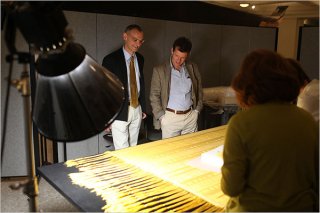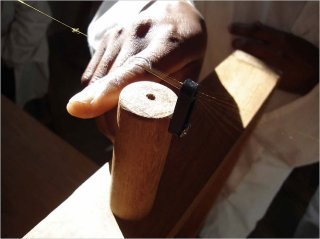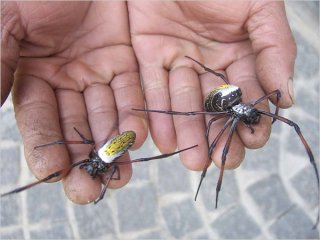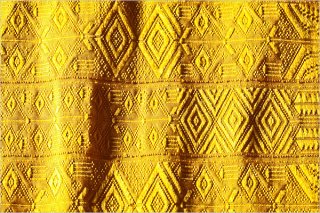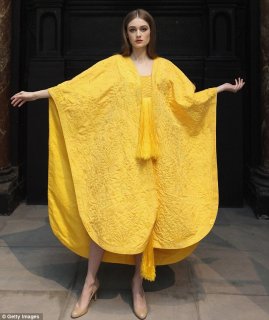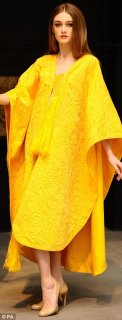The gossamer cape: spun by a million spiders
It looks like liquid gold and feels as light as a cobweb in the wind. This golden cape is the stuff of fairytales: the largest garment ever made entirely of spider silk. As it goes on show at the V&A, Denna Jones meets the duo behind the gossamer revival
"The geeks love this," says Nicholas Godley, smiling broadly. Before us lies a sumptuous silk cape, its natural colour – saffron tinted with watered pink – giving it an unearthly quality. It is an attractive piece of couture, but it is also superhero garb: for this cape was created by spiders.
We are closeted in a workroom in the V&A, with Godley's friend and business partner Simon Peers. Godley, an entrepreneur, met Peers, an art historian and textile expert, in Madagascar. Peers had a spider- silk spooling device in his office there and Godley convinced him to use it to recreate a technique not practised for more than a century.
The Golden Orb spider – with its leg span as big as a hand – is common in Madagascar. Although other species can be "silked", the Golden Orb's silken threads are beyond compare. This month, a V&A exhibition showcases the cape, as well as objects telling the remarkable history of spider-silk weaving.
It was in 1710 that a Frenchman, François Xavier Bon de Saint Hilaire, first showed Europeans that fabric could be spun from spider silk. He boiled their cocoons, extracting the threads with combs to make socks and gloves.
Then, in the early 19th century, along came Jesuit priest Raimondo Maria de Termeyer, who discovered that threads extracted from the spider itself produced a higher-quality silk. An 1807 engraving shows de Termeyer's extraction device. The spider is clamped by a sheet of wood with a half-moon aperture for its abdomen. A winding machine draws out a continuous strand. In the late 19th century, Madagascar's French colonial government encouraged spider-silk weaving, and spider-silk bed hangings were exhibited in Paris. But the drapes disappeared, as did the industry.
Godley and Peers's workshop in Madagascar now has "several" machines similar to the one used by Termeyer. In each hand-powered contraption are 24 females (they are always female). Handlers pull and spool strands from each spider's multiple spinnerets. A gossamer thread is made from 96 twisted strands.
The cape took four years, 1.2m spiders to produce. When Peers and Godley toured its prototype in the US – a 4m length of woven spider silk – comicbook fans loved it. "Their number one question was, 'Is it bullet proof?'" says Godley. Sadly, it isn't. But their questions subtly altered the piece Peers and Godley designed. Embellishments celebrate the spider in myth and metaphor. Every element is made of spider silk.
It has one especially appealing feature. "It's like an invisibility cloak," says Godley, "because you can't feel spider silk." I test this by holding my palms out, eyes closed. When asked whether either or both hands hold part of the cape, I can't tell. "If we hadn't made the cape," says Peers, "this silk would be webs in the wind. That's part of the magic. It's something so ephemeral and yet somehow we've managed to capture it."
The spiders that created it have been released – spent but unharmed. (guardian.co.uk)
See it at the V&A from 25 January–5 June (vam.ac.uk)
It looks like liquid gold and feels as light as a cobweb in the wind. This golden cape is the stuff of fairytales: the largest garment ever made entirely of spider silk. As it goes on show at the V&A, Denna Jones meets the duo behind the gossamer revival
"The geeks love this," says Nicholas Godley, smiling broadly. Before us lies a sumptuous silk cape, its natural colour – saffron tinted with watered pink – giving it an unearthly quality. It is an attractive piece of couture, but it is also superhero garb: for this cape was created by spiders.
We are closeted in a workroom in the V&A, with Godley's friend and business partner Simon Peers. Godley, an entrepreneur, met Peers, an art historian and textile expert, in Madagascar. Peers had a spider- silk spooling device in his office there and Godley convinced him to use it to recreate a technique not practised for more than a century.
The Golden Orb spider – with its leg span as big as a hand – is common in Madagascar. Although other species can be "silked", the Golden Orb's silken threads are beyond compare. This month, a V&A exhibition showcases the cape, as well as objects telling the remarkable history of spider-silk weaving.
It was in 1710 that a Frenchman, François Xavier Bon de Saint Hilaire, first showed Europeans that fabric could be spun from spider silk. He boiled their cocoons, extracting the threads with combs to make socks and gloves.
Then, in the early 19th century, along came Jesuit priest Raimondo Maria de Termeyer, who discovered that threads extracted from the spider itself produced a higher-quality silk. An 1807 engraving shows de Termeyer's extraction device. The spider is clamped by a sheet of wood with a half-moon aperture for its abdomen. A winding machine draws out a continuous strand. In the late 19th century, Madagascar's French colonial government encouraged spider-silk weaving, and spider-silk bed hangings were exhibited in Paris. But the drapes disappeared, as did the industry.
Godley and Peers's workshop in Madagascar now has "several" machines similar to the one used by Termeyer. In each hand-powered contraption are 24 females (they are always female). Handlers pull and spool strands from each spider's multiple spinnerets. A gossamer thread is made from 96 twisted strands.
The cape took four years, 1.2m spiders to produce. When Peers and Godley toured its prototype in the US – a 4m length of woven spider silk – comicbook fans loved it. "Their number one question was, 'Is it bullet proof?'" says Godley. Sadly, it isn't. But their questions subtly altered the piece Peers and Godley designed. Embellishments celebrate the spider in myth and metaphor. Every element is made of spider silk.
It has one especially appealing feature. "It's like an invisibility cloak," says Godley, "because you can't feel spider silk." I test this by holding my palms out, eyes closed. When asked whether either or both hands hold part of the cape, I can't tell. "If we hadn't made the cape," says Peers, "this silk would be webs in the wind. That's part of the magic. It's something so ephemeral and yet somehow we've managed to capture it."
The spiders that created it have been released – spent but unharmed. (guardian.co.uk)
See it at the V&A from 25 January–5 June (vam.ac.uk)


